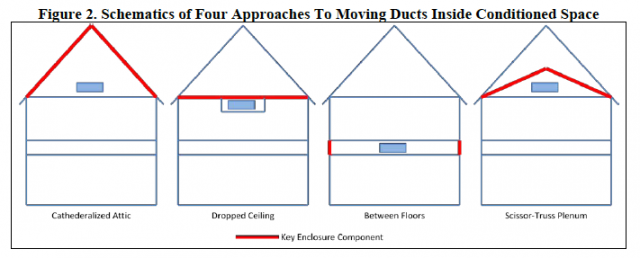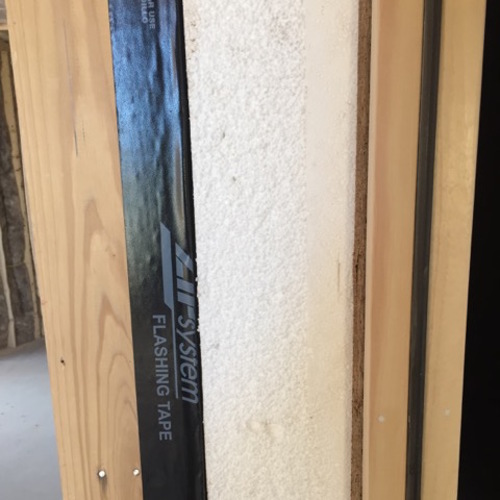
Image Credit: Energy Vanguard
Image Credit: Energy Vanguard Image 2. Ducts in a sealed attic, insulated with spray foam
Image Credit: Energy Vanguard Image 3. Construction of a lowered soffit for ducts in a Habitat for Humanity home in Alabama.
Image Credit: Alexander Bell Image 4. The duct for this room in an Alabama tract house ran through a cavity above the cabinets.
Image Credit: Alexander Bell Image 5. Ducts running through floor trusses Image 6. A stunningly awful way to get ducts in conditioned space.
Image Credit: HVAC Hacks and Other Screwups
I’m a big advocate of getting ducts inside the building enclosure. In cooling climates, getting ducts out of an unconditioned attic can save you 15% on your electricity bills. It can reduce the size of air conditioner you need by 25%. If it’s not in such a harsh environment, your air conditioner will last longer, too.
But how do you get your ducts inside the conditioned (or semi-conditioned) space? I’ll give you an overview of 6 good ways to do it, a couple of great resources to help you, and then one stunningly awful way to bring your ducts inside.
Weekly Newsletter
Get building science and energy efficiency advice, plus special offers, in your inbox.
Six good ways to get the ducts inside
First, I’ll show you 6 acceptable ways to get those ducts inside the building enclosure. The first one is what you see in the photo above: Put the ducts right in the conditioned space and leave them exposed. It’s the most obvious way to bring ducts into the conditioned space, but you don’t see that much in homes. (The photo of that duct donut above in a big plant store in the Atlanta area is interesting also because it has multiple air handlers connected to the same duct system.)
The next four are shown below in a diagram from the paper by Dave Roberts and Jon Winkler of the National Renewable Energy Lab (NREL) that I wrote about a while back. (That’s also the paper that the above statistics come from.)
The second good method then would be the first of their four approaches: You move the building enclosure to the roofline so the attic becomes conditioned space (see Image #2, below). Roberts and Winkler call this a “cathedralized attic,” and you can do it with spray foam insulation under the roof deck, structural insulated panels, or rigid insulation (foam, foam glass, or mineral wool) on top of the roof deck.
The third good method is a lowered ceiling or soffit in the house, and that keeps the ducts below the attic. This one can work well but requires careful detailing. Image #3 (below) shows a Habitat for Humanity home under construction in Alabama. Notice the furred-down soffit next to mechanical closet in the conditioned space. Notice also that each side has a rigid air barrier material (foam board on the left and drywall on the right) separating the duct space from the attic. It’s important to make sure the the dropped soffit doesn’t have air leaks to the attic.
The fourth good method is putting ducts between conditioned floors in a multi-story house. You can do this best with open-web floor trusses, as shown in Image #5 (below). A lot of times, ducts run through floor systems are not installed well because of the battle of the trades. The HVAC contractor, plumber, electrician, and structured wiring company all fight against each other for space in those tight cavities.
The fifth good method is to put the ducts in the attic, sort of, but below the building enclosure with some help from a special type of scissor truss. I don’t have a photo of this one because I’ve never seen it done. This one also would be tricky, especially if you were to put the air handler in that space as well.
The sixth good method, which isn’t shown in that paper from NREL, is to put the ducts in a conditioned crawl space. This was the approach taken at a house that I visited in Nashville recently. Encapsulating crawl spaces is the right thing to do, especially in humid climates, because vented crawl spaces and the psychrometric chart are not friends.
I’ve just shown you the bare minimum here. The devil is indeed in the details, though, and you’re in luck. The Earth Advantage Institute out in the Northwest (US) has put together a great resource for designers, builders, trade contractors, or anyone trying to figure out exactly how to get your ducts inside the conditioned space. They have a website called Ducts Inside, and it’s packed with great information: implementation strategies, a training manual, case studies, and more. Check it out!
And one really bad way…
Finally, let’s get to that one bad way to get ducts inside that I promised you. The last photo below, from HVAC hacks and other screwups, shows it in all its glory.
Wow! Uh… that isn’t really what we mean when we say to put the ducts inside. Yes, they’re definitely in conditioned space, but I have a hard time trying to figure out how someone decided to do this. Yes, to an engineer, this really is no different than the first photo above (ignoring issues of air flow caused by poor installation). Even if they had installed the flex duct properly, that’s just too awful to live with.
A word on new homes vs. existing homes
Getting the ducts into conditioned space is much easier when you can do it in the design phase of a new home, which is what I’m addressing in this article. Once the house is built and the ducts are installed, your options are greatly reduced. If the ducts are in an unconditioned attic, you can put spray foam insulation under the roof deck. If the ducts are in an unconditioned crawl space, you can encapsulate the crawl space. In existing homes, it may well be more cost-effective to seal and insulate the ducts as well as you can and leave them in the unconditioned space.
The bottom line is that there are many ways to get your ducts inside the conditioned space. As with anything, though, you can do it like a hack or you can do it like a pro. Don’t be a hack.
Allison Bailes of Decatur, Georgia, is a speaker, writer, energy consultant, RESNET-certified trainer, and the author of the Energy Vanguard Blog. You can follow him on Twitter at @EnergyVanguard.
















4 Comments
Existing ducts in unconditioned space
Unfortunately, as with many folks, we already have our ducts in unconditioned space and it's not possible to move them. However, we're in the midst of a renovation & want to see what else we can do. We'll explore insulating the attic & creating a partially-conditioned space...however not sure that will be cost-feasible at this stage. Looking for other options.
One thought: as part of renovation, we're planning planning to add additional cellulose insulation to the attic. While this shouldn't directly impact the duct work (most of the duct work isn't on the ground), is it possible to add additional insulation to the ducts (currently R-8) without causing sagging or other issues?
Thoughts appreciated,
Rob (Zone 2A)
Response to Robert Hallenbeck
Robert,
Q. "Is it possible to add additional insulation to the ducts (currently R-8) without causing sagging or other issues?"
A. The answer depends on the type of ducts in your attic and the skill of the person doing the work. It's certainly easier to add insulation to well-supported galvanized ducts than to flex duct.
If you decide to do the work, make sure that all ducts are well supported on hangers, all duct seams are properly sealed, and the new insulation that you install is installed neatly and is carefully protected by a new jacket.
Follow-up
Sorry - should've specified in original posting: all flexible ducts supported via webbing. My concern is the added weight of insulation around the duct will cause it to sag & restrict airflow, negating the system benefit of more insulation.
If we can get around/past the risk of sagging, what kind of insulation would you suggest? We're using a combination of blown-in cellulose and rigid foam elsewhere in the house. Was thinking about some kind of blanket insulation for this application, but not sure how you'd I'd seal it.
Response to Robert Hallenbeck
Robert,
Several manufacturers sell duct insulation; see (for example) the links below:
Johns Manville duct insulation
More info on Johns Manville duct insulation
CertainTeed duct insulation
These insulation materials come with a vinyl jacket or a metalized jacket that acts as a vapor barrier. When this type of insulation is installed, it is important to seal the seams with tape.
Note that this type of duct insulation is intended for galvanized ducts. If you have flex ducts that are poorly insulated, it's usually easier to remove the old flex duct and replace it with new, insulated flex duct. New insulated flex duct is available in R-8 versions.
Log in or create an account to post a comment.
Sign up Log in